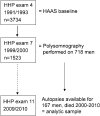Associations of brain lesions at autopsy with polysomnography features before death
- PMID: 25503626
- PMCID: PMC4335994
- DOI: 10.1212/WNL.0000000000001163
Associations of brain lesions at autopsy with polysomnography features before death
Abstract
Objective: To determine how sleep-disordered breathing, nocturnal hypoxia, and changes in sleep architecture in the elderly may be related to the development of the neuropathologic correlates of dementia.
Methods: The Honolulu-Asia Aging Study is a prospective cohort study of Japanese American men in Honolulu, HI. We examined brain lesions at autopsy (Braak stage, neurofibrillary tangle and neuritic plaque counts, microinfarcts, generalized brain atrophy, lacunar infarcts, Lewy bodies [LBs], neuronal loss and gliosis in the locus ceruleus) in 167 participants who underwent polysomnography in 1999-2000 (mean age, 84 years) and died through 2010 (mean 6.4 years to death). Polysomnography measures included the apnea-hypopnea index, duration of apnea or hypopnea, duration of hypoxemia, minimum oxygen saturation (SpO₂), duration of slow-wave sleep (SWS, non-REM stage N3), and arousals.
Results: Sleep duration with SpO₂ <95% was associated with higher levels of microinfarcts (adjusted odds ratio [OR] 3.88, 95% confidence interval [CI] 1.10-13.76, comparing the highest to lowest quartiles of %sleep with SpO₂ <95%). Greater SWS duration was associated with less generalized atrophy (adjusted OR 0.32, 95% CI 0.10-1.03, comparing highest to lowest quartiles of %sleep in SWS). LBs were less common with greater %sleep with SpO₂ <95% (adjusted OR 0.17, 95% CI 0.04-0.78, comparing highest to lowest quartiles). Higher minimum SpO₂ during REM sleep was associated with less gliosis and neuronal loss in the locus ceruleus. Cognitive scores declined less among men with greater SWS duration.
Conclusions: The findings support a role for lower nocturnal oxygenation and SWS in the development of microinfarcts and brain atrophy, but not Alzheimer lesions or LBs.
© 2014 American Academy of Neurology.
Figures
Similar articles
-
Microinfarcts, brain atrophy, and cognitive function: the Honolulu Asia Aging Study Autopsy Study.Ann Neurol. 2011 Nov;70(5):774-80. doi: 10.1002/ana.22520. Ann Neurol. 2011. PMID: 22162060 Free PMC article.
-
Neuropathologic basis of age-associated brain atrophy.JAMA Neurol. 2013 May;70(5):616-22. doi: 10.1001/jamaneurol.2013.1957. JAMA Neurol. 2013. PMID: 23552688 Free PMC article.
-
Clinician-judged hearing impairment and associations with neuropathologic burden.Neurology. 2020 Sep 22;95(12):e1640-e1649. doi: 10.1212/WNL.0000000000010575. Epub 2020 Aug 5. Neurology. 2020. PMID: 32759190 Free PMC article.
-
Sleep-disordered breathing, hypoxia, and risk of mild cognitive impairment and dementia in older women.JAMA. 2011 Aug 10;306(6):613-9. doi: 10.1001/jama.2011.1115. JAMA. 2011. PMID: 21828324 Free PMC article.
-
Trajectories of physical function prior to death and brain neuropathology in a community-based cohort: the act study.BMC Geriatr. 2017 Nov 2;17(1):258. doi: 10.1186/s12877-017-0637-7. BMC Geriatr. 2017. PMID: 29096630 Free PMC article.
Cited by
-
Small Vessel Disease.Front Neurol. 2019 Sep 24;10:1020. doi: 10.3389/fneur.2019.01020. eCollection 2019. Front Neurol. 2019. PMID: 31616367 Free PMC article. Review.
-
Sleep Disturbance as Potential Risk and Progression Factor for Parkinson's Disease.J Parkinsons Dis. 2019;9(3):603-614. doi: 10.3233/JPD-191627. J Parkinsons Dis. 2019. PMID: 31227656 Free PMC article. Review.
-
The Study of Neurocognitive Outcomes, Radiological and Retinal Effects of Aspirin in Sleep Apnoea- rationale and methodology of the SNORE-ASA study.Contemp Clin Trials. 2018 Jan;64:101-111. doi: 10.1016/j.cct.2017.10.016. Epub 2017 Oct 31. Contemp Clin Trials. 2018. PMID: 29097299 Free PMC article. Clinical Trial.
-
A polysomnographic study of slow-wave sleep loss in elderly patients with epilepsy.Heliyon. 2024 Feb 10;10(4):e25904. doi: 10.1016/j.heliyon.2024.e25904. eCollection 2024 Feb 29. Heliyon. 2024. PMID: 38379992 Free PMC article.
-
Insomnia Symptoms Are Associated with Measures of Functional Deterioration and Dementia Status in Adults with Down Syndrome at High Risk for Alzheimer's Disease.J Alzheimers Dis. 2024;100(2):613-629. doi: 10.3233/JAD-220750. J Alzheimers Dis. 2024. PMID: 38875029 Free PMC article.
References
-
- Syme SL, Marmot MG, Kagan A, Kato H, Rhoads G. Epidemiologic studies of coronary heart disease and stroke in Japanese men living in Japan, Hawaii and California: introduction. Am J Epidemiol 1975;102:477–480. - PubMed
Publication types
MeSH terms
Grants and funding
LinkOut - more resources
Full Text Sources
Other Literature Sources
Medical

